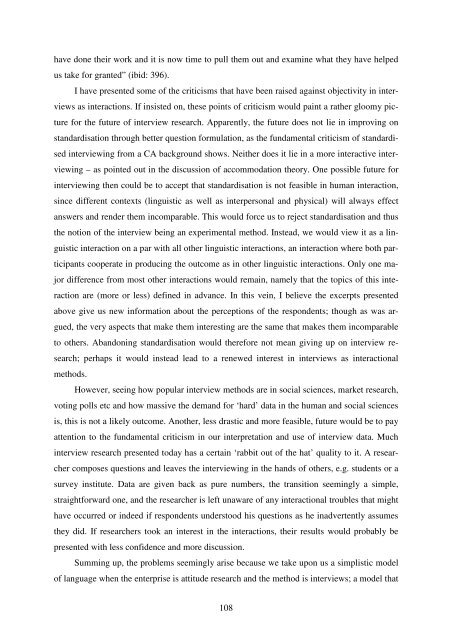Hør dog hvad de siger - Note-to-Self: Trials & Errors
Hør dog hvad de siger - Note-to-Self: Trials & Errors
Hør dog hvad de siger - Note-to-Self: Trials & Errors
Create successful ePaper yourself
Turn your PDF publications into a flip-book with our unique Google optimized e-Paper software.
have done their work and it is now time <strong>to</strong> pull them out and examine what they have helped<br />
us take for granted” (ibid: 396).<br />
I have presented some of the criticisms that have been raised against objectivity in inter-<br />
views as interactions. If insisted on, these points of criticism would paint a rather gloomy pic-<br />
ture for the future of interview research. Apparently, the future does not lie in improving on<br />
standardisation through better question formulation, as the fundamental criticism of standardi-<br />
sed interviewing from a CA background shows. Neither does it lie in a more interactive inter-<br />
viewing – as pointed out in the discussion of accommodation theory. One possible future for<br />
interviewing then could be <strong>to</strong> accept that standardisation is not feasible in human interaction,<br />
since different contexts (linguistic as well as interpersonal and physical) will always effect<br />
answers and ren<strong>de</strong>r them incomparable. This would force us <strong>to</strong> reject standardisation and thus<br />
the notion of the interview being an experimental method. Instead, we would view it as a lin-<br />
guistic interaction on a par with all other linguistic interactions, an interaction where both par-<br />
ticipants cooperate in producing the outcome as in other linguistic interactions. Only one ma-<br />
jor difference from most other interactions would remain, namely that the <strong>to</strong>pics of this inte-<br />
raction are (more or less) <strong>de</strong>fined in advance. In this vein, I believe the excerpts presented<br />
above give us new information about the perceptions of the respon<strong>de</strong>nts; though as was ar-<br />
gued, the very aspects that make them interesting are the same that makes them incomparable<br />
<strong>to</strong> others. Abandoning standardisation would therefore not mean giving up on interview re-<br />
search; perhaps it would instead lead <strong>to</strong> a renewed interest in interviews as interactional<br />
methods.<br />
However, seeing how popular interview methods are in social sciences, market research,<br />
voting polls etc and how massive the <strong>de</strong>mand for ‘hard’ data in the human and social sciences<br />
is, this is not a likely outcome. Another, less drastic and more feasible, future would be <strong>to</strong> pay<br />
attention <strong>to</strong> the fundamental criticism in our interpretation and use of interview data. Much<br />
interview research presented <strong>to</strong>day has a certain ‘rabbit out of the hat’ quality <strong>to</strong> it. A resear-<br />
cher composes questions and leaves the interviewing in the hands of others, e.g. stu<strong>de</strong>nts or a<br />
survey institute. Data are given back as pure numbers, the transition seemingly a simple,<br />
straightforward one, and the researcher is left unaware of any interactional troubles that might<br />
have occurred or in<strong>de</strong>ed if respon<strong>de</strong>nts un<strong>de</strong>rs<strong>to</strong>od his questions as he inadvertently assumes<br />
they did. If researchers <strong>to</strong>ok an interest in the interactions, their results would probably be<br />
presented with less confi<strong>de</strong>nce and more discussion.<br />
Summing up, the problems seemingly arise because we take upon us a simplistic mo<strong>de</strong>l<br />
of language when the enterprise is attitu<strong>de</strong> research and the method is interviews; a mo<strong>de</strong>l that<br />
108



